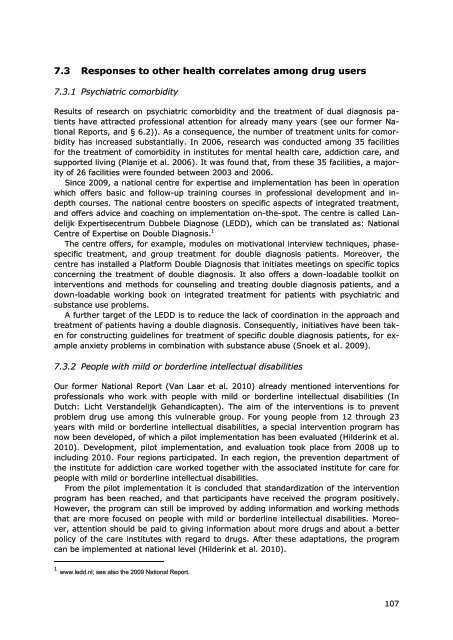The Netherlands Drug Situation 2010 - Trimbos-instituut
The Netherlands Drug Situation 2010 - Trimbos-instituut
The Netherlands Drug Situation 2010 - Trimbos-instituut
Create successful ePaper yourself
Turn your PDF publications into a flip-book with our unique Google optimized e-Paper software.
7.3 Responses to other health correlates among drug users7.3.1 Psychiatric comorbidityResults of research on psychiatric comorbidity and the treatment of dual diagnosis patientshave attracted professional attention for already many years (see our former NationalReports, and § 6.2)). As a consequence, the number of treatment units for comorbidityhas increased substantially. In 2006, research was conducted among 35 facilitiesfor the treatment of comorbidity in institutes for mental health care, addiction care, andsupported living (Planije et al. 2006). It was found that, from these 35 facilities, a majorityof 26 facilities were founded between 2003 and 2006.Since 2009, a national centre for expertise and implementation has been in operationwhich offers basic and follow-up training courses in professional development and indepthcourses. <strong>The</strong> national centre boosters on specific aspects of integrated treatment,and offers advice and coaching on implementation on-the-spot. <strong>The</strong> centre is called LandelijkExpertisecentrum Dubbele Diagnose (LEDD), which can be translated as: NationalCentre of Expertise on Double Diagnosis. 1<strong>The</strong> centre offers, for example, modules on motivational interview techniques, phasespecifictreatment, and group treatment for double diagnosis patients. Moreover, thecentre has installed a Platform Double Diagnosis that initiates meetings on specific topicsconcerning the treatment of double diagnosis. It also offers a down-loadable toolkit oninterventions and methods for counseling and treating double diagnosis patients, and adown-loadable working book on integrated treatment for patients with psychiatric andsubstance use problems.A further target of the LEDD is to reduce the lack of coordination in the approach andtreatment of patients having a double diagnosis. Consequently, initiatives have been takenfor constructing guidelines for treatment of specific double diagnosis patients, for exampleanxiety problems in combination with substance abuse (Snoek et al. 2009).7.3.2 People with mild or borderline intellectual disabilitiesOur former National Report (Van Laar et al. <strong>2010</strong>) already mentioned interventions forprofessionals who work with people with mild or borderline intellectual disabilities (InDutch: Licht Verstandelijk Gehandicapten). <strong>The</strong> aim of the interventions is to preventproblem drug use among this vulnerable group. For young people from 12 through 23years with mild or borderline intellectual disabilities, a special intervention program hasnow been developed, of which a pilot implementation has been evaluated (Hilderink et al.<strong>2010</strong>). Development, pilot implementation, and evaluation took place from 2008 up toincluding <strong>2010</strong>. Four regions participated. In each region, the prevention department ofthe institute for addiction care worked together with the associated institute for care forpeople with mild or borderline intellectual disabilities.From the pilot implementation it is concluded that standardization of the interventionprogram has been reached, and that participants have received the program positively.However, the program can still be improved by adding information and working methodsthat are more focused on people with mild or borderline intellectual disabilities. Moreover,attention should be paid to giving information about more drugs and about a betterpolicy of the care institutes with regard to drugs. After these adaptations, the programcan be implemented at national level (Hilderink et al. <strong>2010</strong>).1 www.ledd.nl; see also the 2009 National Report.107




